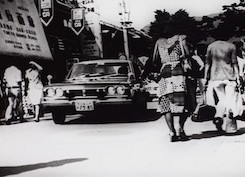This desire, dispersed throughout the exhibition hall, is almost palpable. The black-and-white images by the Japanese artist Idemitsu Mako make use of the sense of nostalgia inherent within old movies, giving viewers a feeling of temporal and spatial anxiety. The portraits by Sawada Tomoko of young Japanese girls in various attire make one feel the unease in the recreation of identities by contemporary youngsters in their search for a sense of belonging. Meanwhile, the Korean artist Song Hyunsook strove to convey, through traditional Eastern painting techniques, the quintessence of Eastern Zen Buddhism onto images with certain Korean characteristics.
Elsewhere, the Taiwanese artist Tu Weicheng, who has always been obsessed with objects that bears the weight of history and civilization, focuses on old Shanghai-style furniture in his installation. Such Western-style furniture created in Shanghai’s early years also echoes the colonialist history of the city. As part of an exhibition aiming to achieve an independent Asian language, this ambivalent form is overlaid with images that represent everyday life in urban Shanghai. This excessive intuition brings about a strong self-expressiveness and undoubted entertaining value. Adults come to a halt in front of the work while children stop to fiddle with the various handles connected to it. Amid the good old days fondly recreated by objects from the past, the clash of history is drowned in pure fetishism.
Likewise, the video work by Korean artist Won Seoungwon relies too much on modified and recycled computer software. The artist’s own childhood experiences can be seen on the 11 sentimental tableaux, with the landscape and objects all immersed in aesthetic, emotive notions of the East. The repetition and narcissism of these tableaux give off the stale scent of how the East was seen by the West. In a historical retrospective filled with individual feelings, the artist tries to place her own creations against the background of local places being ruthlessly devoured by globalization. Accordingly, all the objects with “Korean” sentiments end up merely making the artworks recollections of recollections.
On a rapidly globalizing world stage, China, Japan and Korea, with their intricate historical, political and economic backgrounds, all emerge with an “East Asian” identity, and this in itself is an expression of conflicts and problems. This notion of “East Asia” renders the voice of this “Other” — which opposes global process of development by representations of nationalism, revisiting history and origins — rather unharmonious. Who is being nostalgic? Nostalgic about what? What kind of history created the situation in which today’s traditional culture is in danger of abandonment and replacement by Western civilization? And who is writing this history?
When highlighting the development of globalization under the new world order, the British cultural scholar Stuart Hall pointed out that the local is opposed to the global and that the development of globalization will not simply be a peaceful evolutionary process at the final stage of history. The development of globalization takes place in a post-modern space filled with conflicts, many of which are not new but are a continuation of a historical process. (1)
